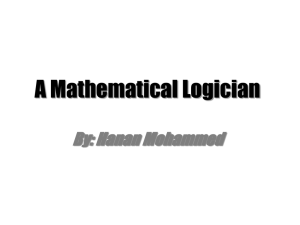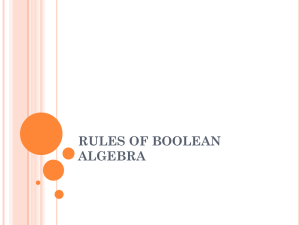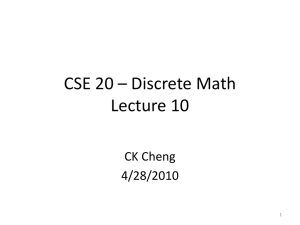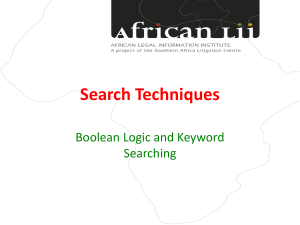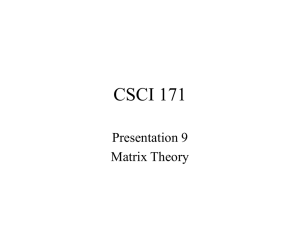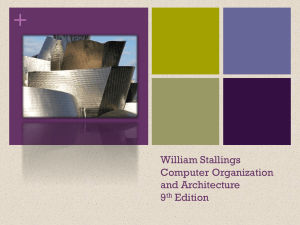a a+1
advertisement
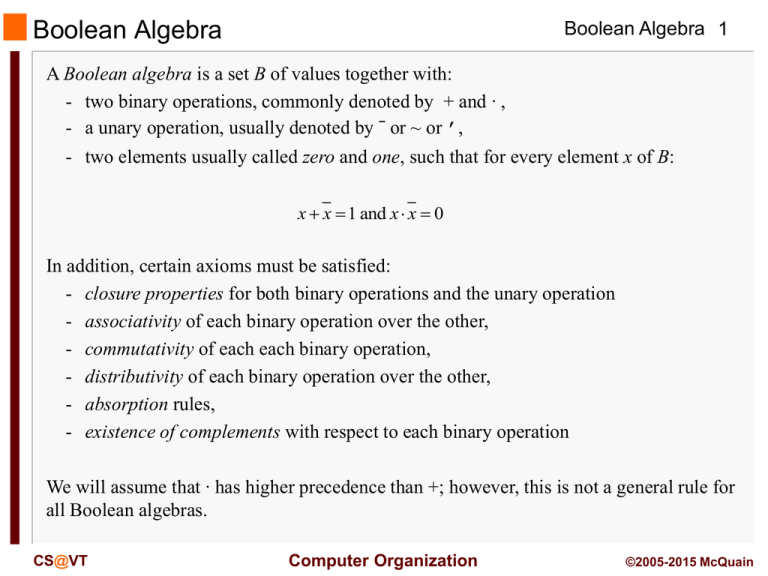
Boolean Algebra
Boolean Algebra 1
A Boolean algebra is a set B of values together with:
- two binary operations, commonly denoted by + and ∙ ,
- a unary operation, usually denoted by ˉ or ~ or ’,
- two elements usually called zero and one, such that for every element x of B:
x x 1 and x x 0
In addition, certain axioms must be satisfied:
- closure properties for both binary operations and the unary operation
- associativity of each binary operation over the other,
- commutativity of each each binary operation,
- distributivity of each binary operation over the other,
- absorption rules,
- existence of complements with respect to each binary operation
We will assume that ∙ has higher precedence than +; however, this is not a general rule for
all Boolean algebras.
CS@VT
Computer Organization
©2005-2015 McQuain
Axioms of Boolean Algebra
Boolean Algebra 2
Associative Laws: for all a, b and c in B,
(a b) c a (b c)
(a b) c a (b c)
Commutative Laws: for all a and b in B,
ab ba
a b b a
Distributive Laws: for all a, b and c in B,
a (b c) (a b) (a c)
a (b c) (a b) (a c)
Absorption Laws: for all a, b and c in B,
a (a b) a
a (a b) a
Existence of Complements: for all a in B, there exists an element ā in B such that
a a 1
CS@VT
aa 0
Computer Organization
©2005-2015 McQuain
Examples of Boolean Algebras
Boolean Algebra 3
The classic example is B = {true, false} with the operations AND, OR and NOT.
An isomorphic example is B = {1, 0} with the operations +, ∙ and ~ defined by:
a
b
a+b
a*b
~a
0
0
0
0
1
1
0
1
0
0
0
1
1
0
1
1
1
1
Given a set S, the power set of S, P(S) is a Boolean algebra under the operations union,
intersection and relative complement.
Other, interesting examples exist…
CS@VT
Computer Organization
©2005-2015 McQuain
More Properties
Boolean Algebra 4
It's also possible to derive some additional facts, including:
- the elements 0 and 1 are unique
- the complement of an element a is unique
- 0 and 1 are complements of each other
CS@VT
Computer Organization
©2005-2015 McQuain
DeMorgan's Laws & More
Boolean Algebra 5
DeMorgan's Laws are useful theorems that can be derived from the fundamental
properties of a Boolean algebra.
For all a and b in B,
a b a b
a b a b
Of course, there’s also a double-negation law:
aa
aa a
a a a
And there are idempotency laws:
Boundedness properties:
CS@VT
a0 a
a0 0
a 1 1
a 1 a
Computer Organization
©2005-2015 McQuain
Logic Expressions and Equations
Boolean Algebra 6
A logic expression is defined in terms of the three basic Boolean operators and variables
which may take on the values 0 and 1. For example:
z : x0 y0 x0 y0
y : ( x1 x2 ) ( x1 x2 x3 ) x1 ( x2 x3 )
A logic equation is an assertion that two logic equations are equal, where equal means
that the values of the two expressions are the same for all possible assignments of values
to their variables. For example:
x 0 y 0 x0 y0 x0 y0 x 0 y 0
Of course, equations may be true or false. What about the one above?
CS@VT
Computer Organization
©2005-2015 McQuain
Why do they call it "algebra"?
Boolean Algebra 7
A Boolean expression can often be usefully transformed by using the theorems and
properties stated earlier:
x
0
y0 x 0 y 0 x0 y0 x 0 y 0
x0 y0 x0 y0
x0 y0 x0 y0
This is a relatively simple example of a reduction. Try showing the following expressions
are equal:
x0 y0 z0 x0 y0 x0 z0
CS@VT
Computer Organization
©2005-2015 McQuain
Tautologies, Contradictions & Satisfiables
Boolean Algebra 8
A tautology is a Boolean expression that evaluates to true (1) for all possible values of its
variables.
aa
a b a b a b a b
A contradiction is a Boolean expression that evaluates to false (0) for all possible values
of its variables.
aa
A Boolean expression is satisfiable if there is at least one assignment of values to its
variables for which the expression evaluates to true (1).
a b a b
CS@VT
Computer Organization
©2005-2015 McQuain
Truth Tables
Boolean Algebra 9
A Boolean expression may be analyzed by creating a table that shows the value of the
expression for all possible assignments of values to its variables:
CS@VT
a
b
a b
a b
a b a b
0
0
0
1
1
1
0
0
0
0
0
1
0
0
0
1
1
1
0
1
Computer Organization
©2005-2015 McQuain
Proving Equations with Truth Tables
Boolean Algebra 10
Boolean equations may be proved using truth tables (dull and mechanical):
a 1 1
a bc a b c
a
a+1
a
b
c
~(a*b*c)
~a*~b*~c
0
1
0
0
0
1
1
1
1
0
0
1
1
1
0
1
0
1
1
0
1
1
1
1
1
0
0
1
1
1
0
1
1
1
1
1
0
1
1
1
1
1
0
0
CS@VT
Computer Organization
©2005-2015 McQuain
Proving Equations Algebraically
Boolean Algebra 11
Boolean equations may be proved using truth tables, which is dull and boring, or using the
algebraic properties:
a B, a 1 a
a a a a
a 1
absorption, with b a
law of complements
Note the duality
a B, a 0 a
a a aa
a0
CS@VT
absorption, with b a
law of complements
Computer Organization
©2005-2015 McQuain
Proving Equations Algebraically
Boolean Algebra 12
a B, a a a
a a a 1
CS@VT
absorption, with b 1
a a (a a )
law of complements
aa
absorption, with b = a
Computer Organization
©2005-2015 McQuain
Sum-of-Products Form
Boolean Algebra 13
A Boolean expression is said to be in sum-of-products form if it is expressed as a sum of
terms, each of which is a product of variables and/or their complements:
a b a b
It's relatively easy to see that every Boolean expression can be written in this form.
Why?
The summands in the sum-of-products form are called minterms.
- each minterm contains each of the variables, or its complement, exactly once
- each minterm is unique, and therefore so is the representation (aside from order)
CS@VT
Computer Organization
©2005-2015 McQuain
Example
Boolean Algebra 14
Given a truth table for a Boolean function, construction of the sum-of-products
representation is trivial:
- for each row in which the function value is 1, form a product term involving all the
variables, taking the variable if its value is 1 and the complement if the variable's
value is 0
- take the sum of all such product terms
x
y
z
F
0
0
0
0
0
0
1
1
x y z
0
1
0
1
x y z
0
1
1
0
1
0
0
1
1
0
1
0
1
1
0
0
1
1
1
1
CS@VT
x y z
F x y z x y z x y z x y z
x yz
Computer Organization
©2005-2015 McQuain
Product-of-Sums Form
Boolean Algebra 15
A Boolean expression is said to be in product-of-sums form if it is expressed as a product
of terms, each of which is a sum of variables:
a b a b
Every Boolean expression can also be written in this form, as a product of maxterms.
Facts similar to the sum-of-products form can also be asserted here.
The product-of-sums form can be derived by expressing the complement of the
expression in sum-of-products form, and then complementing.
CS@VT
Computer Organization
©2005-2015 McQuain
Example
Boolean Algebra 16
Given a truth table for a Boolean function, construction of the product-of-sums
representation is trivial:
- for each row in which the function value is 0, form a product term involving all the
variables, taking the variable if its value is 1 and the complement if the variable's
value is 0
- take the sum of all such product terms; then complement the result
x
y
z
F
0
0
0
0
0
0
1
1
0
1
0
1
0
1
1
0
1
0
0
1
1
0
1
1
1
1
1
CS@VT
x y z
x y z
F x y z x y z x y z x y z
0
x y z
F x y z x y z x y z x y z
0
0
x y z
1
1
( x y z) ( x y z)
( x y z) ( x y z)
Computer Organization
©2005-2015 McQuain
Boolean Functions
Boolean Algebra 17
A Boolean function takes n inputs from the elements of a Boolean algebra and produces a
single value also an element of that Boolean algebra.
For example, here are all possible 2-input Boolean functions on the set {0, 1}:
CS@VT
A
B
zero
and
A
B
xor
or
0
0
0
0
0
0
0
0
0
0
0
1
0
0
0
0
1
1
1
1
1
0
0
0
1
1
0
0
1
1
1
1
0
1
0
1
0
1
0
1
A
B
nor
eq
B'
nand
one
0
0
1
1
1
1
1
1
1
1
0
1
0
0
0
0
1
1
1
1
1
0
0
0
1
1
0
0
1
1
1
1
0
1
0
1
0
1
0
1
A'
Computer Organization
©2005-2015 McQuain
Universality
Boolean Algebra 18
Any Boolean function can be expressed using:
- only AND, OR and NOT
- only AND and NOT
- only OR and NOT
- only AND and XOR
- only NAND
- only NOR
The first assertion should be entirely obvious.
The remaining ones are obvious if you consider how to represent each of the functions in
the first set using only the relevant functions in the relevant set.
CS@VT
Computer Organization
©2005-2015 McQuain

